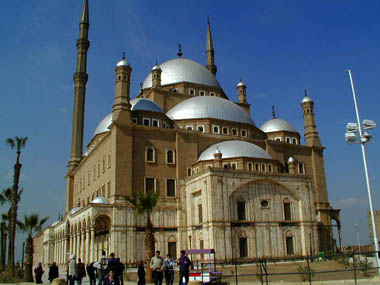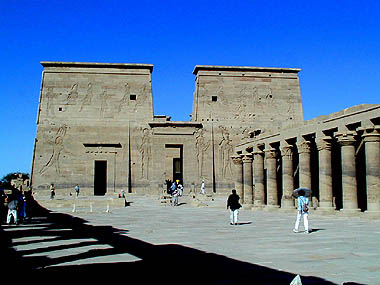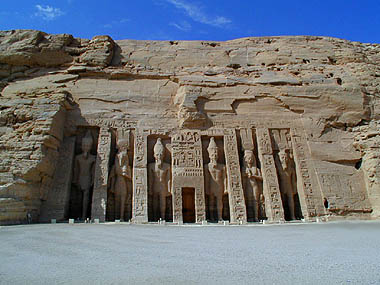

Surreal and spectacular, last of the Seven Wonders of Antiquity, unmistakable symbol of ancient civilizations, the Pyramids stand in the desert next to the life-giving source of Egypt, the Nile. Proud and honorable, they seem to defy time and change, the modern life that keeps growing around them, increasing pollution and chaos. The pharaohs built these awesome structures as a testament to their power, and to ensure a luxurious journey into the afterlife. Archaeologists still search for detailed documents explaining how they were built. No less significant is the miracle of the Nile that has held back the advances of the desert, and supported the people for over eight thousand years. Seeing it snake through the middle of two virtually lifeless bodies of sand, lush and green with date palms, grass and crops springing from its banks, you recognize a body that deserves to be worshipped as a divine entity. Like a call to worship, we were drawn to experience the mysteries of ancient civilization along the Nile.
The flight from Thailand to Cairo was long and indirect. Flying with the United alliance, our connection to Cairo with Lufthansa departed from Frankfurt. A six hour layover didn't help matters, although it did give me an opportunity to buy another digital camera (ask me to tell you that story sometime). We were unprepared for the long lines of smokers, complete disorganization, and cramped spaces as we waited 90 minutes to clear customs in Cairo. Our agency representative insisted that we not handle our own luggage to the point of distress. We were shocked to see our possessions tossed around like bags of garbage. Flying in Egypt was by far our worst travel experience.
Egypt was the only organized portion of our trip, a way of traveling we usually resent. We had purchased the tour over the internet, and weren't exactly sure what to expect. We were pleasantly surprised to discover that we had a personal egyptologist/guide and car with driver during our two day stay in Cairo. Driving through morning rush hour traffic, we noticed trash dumped indiscriminately around the city, and many ugly unfinished residential buildings. Our guide Yassir explained that incomplete structures cannot be taxed by the government, so people don't finish their houses.
But we left the problems of modern society and soon indulged in antiquity's perfection. The look of astonishment, our permanent facial expression for the next four weeks, started to develop at Memphis, ruling city of the Old Kingdom. We couldn't believe the fine condition and detail of the meticulously carved, 45 foot statue of Ramses II, dating back to 1800 B.C. At Sakkara we visited the step pyramid (picture below right), the first attempt at this type of construction, built at 2630 B.C. The Egyptians believed that the pyramid form would gather and store the maximum solar energy - also their main god called Ra. The Pyramids of Giza (opening image) constitute the finest examples of this tomb construction.
Standing next to the base of the largest pyramid (Khufu), one can hardly see the 481 feet high peak, but realizes the gigantic measurements of the limestone blocks used for its construction. We were able to crawl into the smallest of the three pyramids and sense the hot, mystical air inside a tomb chamber. Again we fought our way through tourist masses for an extended glimpse of the majestic sphinx (picture left), whose wise expression gazes somewhat disillusioned toward modern Cairo.
Many ancient crafts are preserved for the buying tourist. Papyrus studios, carpet schools and alabaster workshops line the tourist routes. The carpets are knotted by school children during afternoon lessons. They are paid according to their level of expertise. We enjoyed a presentation of the papyrus paper making procedure, and did buy one of the traditional scenes hand painted on this beautifully structured material.


The brilliance and advancement of the ancient Egyptian civilization becomes most evident at the Cairo Archaeological Museum. We were amazed by the design, engineering and craftsmanship of all the artifacts on display. Giant statues carved out of single blocks of granite included the finest muscular detail. Papyrus papers store ancient stories written in hieroglyphics and illustrated with delicate pictures. Countless glass cases display complex tools for writing, medicine and agriculture.
The exhibit of King Tutankhamon's tomb treasures include the famous mask, wooden folding chairs inlaid with gold and precious stones, game boards, tools, hunting weapons, chariots, jewelry and sandals, all produced 3000 years ago for the king's afterlife. The process of mummification and the building of lasting monuments preserved material and written evidence that allows us to reconstruct life in ancient Egypt and to admire the people's level of knowledge and creativity. The museum resembles a huge, crowded warehouse. Most pieces can not receive the space and attention they deserve. One would need at least a week to search through the various displays and look at everything carefully.
Lunch restored our tired limbs before the car took us to the old part of Cairo. On the desert hills above this area lies the Citadel of Saladin from the 13th century, and the Mohammed Ali Mosque (picture below left), built at the turn of the 19th century by the first ruler of modern Egypt. While we set inside on soft carpets under the colorful dome, Yassir explained the basics of the Muslim religion, including its liberal and radical interpretations. The much older Sultan Hasan Mosque (picture right) doesn't receive as much financial support from the city. The simple, poorly maintained interior still gave this mosque a more oriental and authentic atmosphere. We completed our tour with a stroll through the tiny allies of the Khan El-Khalili Bazaar, where a large variety of carpets, gold, silver, copper and other handicrafts are piled into the smallest stores.


Lined up outside the airport entrance at 6:45 a.m., we were concerned about missing the flight. All passengers enter the terminal through one door, their luggage is passed through either of two x-ray machines. Pushing, shoving and swearing seemed to be the prescribed etiquette. We managed to fight our way through, and arrived mid-morning in Luxor to embark on a four day Nile cruise. We spent most of the afternoon exploring Karnak Temple (below left), a 250 acre complex of temples, chapels and obelisks. The surfaces and walls of each structure have been decorated with relief carvings. We soon recognized the depiction of certain gods and the design of a specific pharaoh's cartouche - the signature symbol. With 134 massive columns, the temple's hall is the largest columnar structure in the world. Only a mile away stands Luxor Temple (below right). This equally impressive structure was once linked to the Temple of Karnak by a wide stone avenue lined with sphinxes. Some parts of this holy pathway have been excavated.


With the boat still anchored in Luxor, we left early for a drive to the Valley of the Kings. The New Kingdom pharaohs probably chose this site because the desert mountain above the outcrop resembles a pyramid (picture first row left). We had time to walk into three tombs, each of them decorated with astonishing carvings (first row right). Many wall decorations still exhibit the original colors (second row right). It is hard to believe, that these delicate reliefs and brilliant pigments have survived thousands of years without damage. The dry, warm climate has certainly helped their preservation. A short drive away lies the Valley of the Queens, where we walked down the long corridors to marvel at two other burial chambers. The same mountain range houses the Temple of Hatshepsut at Deir ElBahary (second row left), built by Egypt's only female pharaoh. The cruise ship left Luxor in the afternoon. Cool weather kept us in our cabin. But the large windows allowed a wide angle view of the date palms, lush clover fields, and mud brick houses along the shore.




Except for the main temple hall (below left), the ruins of Esna Temple are still buried under the homes and shops of the village. Many archeological sites in Egypt still remain untouched under layers of sand or modern construction. While excavations continue, the country can hardly preserve the many existing monuments. Most reconstruction projects have been financed by international organizations.
A short cruise brought us to Edfu, a horse-drawn carriage to the temple dedicated to the falcon god Horus. The strong outer wall and the 90-feet-high pylons (large entrance gate, below right) have been preserved in almost perfect condition. The two pylons symbolize the desert on each side of the Nile, with the river flowing between. Our new guide Abdalah, a senior egyptologist with impressive knowledge, explained the religious stories depicted in larger-than-life carvings inside the offering rooms and temple halls.


Bright sunshine greeted us in Kom Ombo. The temple complex (below left) was built by the Ptolemaic Kings of Egypt's Late Period. Inside this double temple with twin gateways, sanctuaries, and a cemetery for sacred crocodiles (a few mummies still sleep in peace), worshippers celebrated the crocodile god Sobek and the falcon god Horus. Some carvings depict the famous Queen Cleopatra. Others show us medical instruments used in ancient surgical procedures.
We continued sailing to the larger city of Aswan. Sitting back on an upper deck chair, we enjoyed the constantly changing shore landscape: small islands surrounded by papyrus plants, mud brick villages standing camouflaged against the desert dunes, peasants leading their donkeys to the water, the women carrying vessels on their heads, a small stripe of lush vegetation contrasting with the pale yellow dryness of sand mountains behind. From far away an exotic African fairy tale. But we don't know the true story. The peasant population still lives in third world conditions, even though rural life seems to improve. The villagers now receive medical attention, children learn in modern school buildings, and pumping stations provide filtered water.
Abdalah welcomed us in his hometown Aswan for an action packed afternoon. An ancient granite quarry still holds one unfinished obelisk. The block had cracked during the work and had never been touched again. Today it provides many clues about the ancient work process. We briefly visited the High Dam, now regulating the flow of the Nile and storing enough water for dry periods. The Temple of Isis on Philae Island (below right) had to be transferred from its original site during the 1960's to save it from being covered by the waters of Lake Naser created behind the High Dam. Abdalah was part of an Egyptian team that dismantled the temple, catalogued every piece and rebuilt it on a more elevated island. The project took eight years. During our tour of the grounds, he told us about the difficulties and success stories during the reconstruction.
We spend the remaining hours of daylight on board a traditional Nile sailboat called felucca (picture underneath). Two young boys tacked the boat downstream and around an island before the perfect breeze blew into the hand-sewn sails and carried us toward Aswan's Botanical Garden. This oasis of palm, gum and eucalyptus trees and blooming bushes has to be watered with enormous effort. A layer of sand dust still covers the leaves and blossoms. We watched the sun setting behind the high, smooth, orange sand dunes along the west shore.



The thought of three Egypt Air flights in one day to visit the temples of Ramses II and Nefertary at Abu Simbel was not appealing at all. But even with the abuse we and our luggage took, the sight of these two unusual temples was worth the trip. The edifices had been completely carved out of limestone mountains. With the threat of Lake Naser's waters, the temples had to be cut out of the mountain face and the entire hill reassembled on the newly created shore. Four gigantic statues of Ramses II, the most powerful and longest reigning pharaoh of ancient Egypt, guard the entrance to his temple (top row left). More of the ideal figures stand tall inside the marvelous temple hall (top row right). With this temple, Ramses II established himself as a god and forced the population of Abu-Simpel to worship him as an immortal deity. A perfectly preserved wall carving shows the great pharaoh and warrior holding his adversaries by their hair. Ramses II loved the depiction of captured enemies, which adorns many walls of other temples as well. The pharaoh ordered a temple for his beloved wife Queen Nefertary to be built into the same mountain (second row right). The colorful wall reliefs within this building have survived the centuries with minor damage.




We spent another comfortable night in a four-star hotel in Cairo. Our travel agency had helped us to book four days in a resort on the Red Sea. After our diving experiences in Thailand, we spontaneously decided to check out the dive spots of these famous waters. Our flight didn't leave until the afternoon, so we used the morning hours for another visit of the Egyptian Museum. We enjoyed roaming the halls on our own, selecting the exhibits and showcases we wanted to inspect.
A week of overwhelming impressions began to tire our senses. We needed some time to processes such data overload. But first, we had to struggle again through airport chaos. We took a full day to sleep, relax and recover in our friendly beach-side room in Huraghada. Unfortunately, our travel agent, not knowledgeable about great diving in the Red Sea, had sent us to the wrong area. The dive spots we were able to reach with day trips had been overdived and almost completely destroyed. The corals lay broken and gray on the ocean floor, few fish visited the wasteland. We did find some new varieties of small reef fish, as well as the cute blue spotted sting rays. But what a sad, disappointing sight, especially after viewing the unspoiled underwater world in Thailand! Strong winds prevented the boat from visiting more remote, less damaged spots. Still, we loved a few quiet days and happily breathed the clean ocean air. Someday, we would like to plan a live aboard dive trip on the Red Sea.
Every person should get the chance to see Egypt's ancient monuments. We had set foot inside the wonders of the most stable civilization we know. Was the existence of this empire and its surviving buildings and artifacts a result of harsh dictatorship and slavery labor, or did these people enjoy the daily work that created such marvels of art and architecture? We want to believe the latter. And remember the glorious version of Egypt.